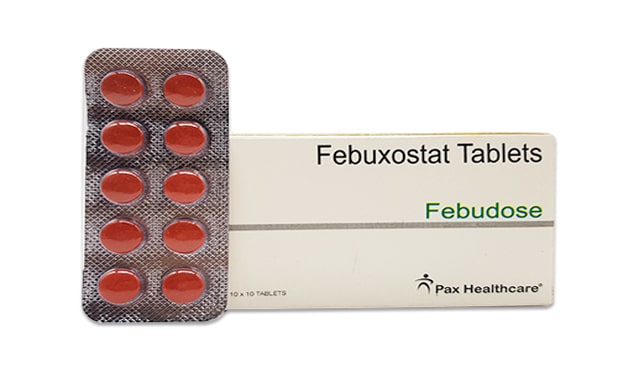Indications:
Febuxostat is a xanthine oxidase inhibitor indicated for the chronic management of hyperuricemia in patients with gout.
Mechanism of Action:
Febuxostat is a xanthine oxidase inhibitor, achieves its therapeutic effect by decreasing serum uric acid. Febuxostat is not expected to inhibit other enzymes involved in purine and pyrimidine synthesis and metabolism at therapeutic concentrations.
Pharmacodynamics:
Effect On Uric Acid: In healthy patients, it is resulted in a dose dependent decrease in 24 hour , there was a decrease in the total daily urinary uric acid excretion. Also, there is an increase in total daily urinary xanthine excretion. Percent reduction in between 24 hour mean serum uric acid concentrations was between 40% and 55% at the exposure levels of 40 mg and 80 mg daily doses.
Pharmacokinetics:
Absorption: The absorption of febuxostat was estimated to be at least 49% ,based on total radioactivity recovered in urine. Maximum plasma concentrations of febuxostat occurred between 1 and 1.5 hours post-dose.Following multiple 80 mg once daily doses with a high fat meal, there was a 49% decrease in Cmax and an 18% decrease in AUC.There is no clinically significant change in the percent decrease in serum uric acid concentration was observed 58% fed vs. 51% fasting.
Distribution: The mean apparent steady state volume of distribution (Vss/F) of febuxostat was approximately 50 L (CV ~40%). The plasma protein binding of febuxostat is approximately 99.2% and is constant over the concentration range achieved with 40 mg and 80 mg doses.
Metabolism: Febuxostat is extensively metabolized by both conjugation via uridine diphosphate glucuronosyltransferase enzymes.
Elimination: Febuxostat is eliminated by both hepatic and renal pathways. Following an 80 mg oral dose of 14C-labeled febuxostat, approximately 49% of the dose was recovered in the urine as unchanged .In addition to the urinary excretion, approximately 45% of the dose was recovered in the feces as the unchanged febuxostat (12%), the acyl glucuronide of the drug (1%), its known oxidative metabolites and their conjugates (25%).
The apparent mean terminal elimination half-life (t1/2) of febuxostat is 5 to 8 hours
Side Effects:
● Yellow colored eyes or skin
● Abdominal pain
● Diarrhea
● Flatulence
● Nausea or Vomiting
● Stomach pain, swelling
● Swelling of your skin
● Mucus discharge
● Rectal bleeding
Contraindications:
● ALLERGY: Acarbose tablet is not recommended in the patients with known allergy.
● Gastrointestinal Disease: Acarbose tablet is not recommended in the patients with history of gastrointestinal disease like inflammatory bowel disease, colonic ulceration or any intestinal obstruction.
